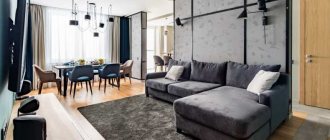Sometimes living space requires division into certain zones. This is implemented not only in small one-room apartments, when it is necessary to separate the sleeping area from the living common space. But also in large rooms of private houses. Here, zoning is performed for other purposes, but can also be used successfully. Therefore, we suggest that you familiarize yourself with how to divide a room with curtains and what you need to take into account for this.
Zoning with curtains is the simplest and most effective way to divide space
Pros and cons of zoning a room with curtains
Zoning a room with curtains is one of the design techniques that should be used taking into account its advantages and disadvantages.
Curtains allow you to hide the everyday clutter in a particular area, while maintaining a feeling of space and freedom
Among the advantages it is worth noting:
- Using this technique allows you to quite easily, quickly and, most importantly, cheaply zone the space of any room in size.
- There is no need for major alterations, so the surrounding space does not need to be rebuilt or redesigned. Accordingly, there is no construction dirt and significant extra financial costs.
- These curtains are easy to use and take up minimal space.
- They can fit into any interior thanks to the use of different fabrics, colors and textures.
Among the disadvantages:
- Any curtains, including those for zoning, are dust collectors. Therefore, in order to avoid negative effects on the body, it is necessary to cleanse it correctly and on time.
- If the model is made of translucent fabric, then it is completely unable to hide a certain part of the room from view.
- They are not able to delay the propagation of sound.
It is very important to consider that if you plan to create a suspended ceiling in a room, then in order to zone the room using curtains, it is necessary to provide a mortgage for the cornice (rail). But, if this option for finishing the space is used when the renovation has already been done, then you can organize a special beam in the form of a figured structure on which the curtain will be hung. But it should be borne in mind that it will not be able to withstand a structure that is too massive, especially if the wall is plasterboard.
Advantages
If we compare this zoning method with others, the advantages of the first are obvious:
- cost-effectiveness in terms of spending money;
- ease of installation;
- saving space;
- the process is reversible - the curtain partition can be removed at any time, and the room will look different. With other zoning options, everything is not so simple: dismantling will take a lot of time and effort;
- Using curtains for zoning, you can successfully hide the flaws of old or unsuccessful repairs.
Examples of zoning a room with curtains
It is necessary to clearly understand that the curtains used for zoning space in a room can be very diverse not only in color and texture, but also in the principle of organization. They can be made of fabric, either dense or translucent. They can be presented in the form of vertical blinds or implemented as thread products that only nominally separate one part of the room from another.
Curtains can be not only functional, but also a purely decorative element of the interior. For example, they are often used to decorate arches and doorways
Zoning with curtains
This method of creating a partition is most often used where it is necessary to separate the sleeping area from the living area. Therefore, such curtains are used in small rooms, for example, in Khrushchev-era apartment buildings, where it is necessary to accommodate more people in relative comfort than the area allowed for. To carefully hide one part of the room from another, it is recommended to use thick, non-transparent curtains.
The choice of pattern on the curtains depends on the style of the room’s interior
In this case, it is important to harmoniously select a color solution similar to the main curtains that cover the window. In this case, the structure is attached to the ceiling and must allow for movement on rails.
Zoning blinds
Sometimes blinds are used to zone space in a room. But it is necessary to understand that this method brings some “coldness” and detachment in its perception to the room. Therefore, it is more suitable for minimalist design trends. Blinds can be used in Scandinavian, post-industrial style, as well as in a room that will be decorated in high-tech, loft or modern style.
Horizontal blinds are very convenient to use, perfectly covering a selected area and easily lifting when necessary.
And others
There is also a thread version of curtains. In this case, the structure consists of special hanging threads that are attached to a strip on the ceiling. At the same time, they conditionally divide the space, since in most cases they are made immovable. They can only be assembled on their sides, forming a sort of arched outline of the edge. And, naturally, they cannot completely visually separate one part of the room from another. Therefore, they are used only to divide one part of the space from another in the living room. That is, for example, the area where food is eaten and where the common guest space is located. In order to form a bedroom compartment, this option is not used.
Thread curtains are perfect for zoning a children's room
Types of fabrics and rules for their use
Decorators actively use:
- cotton;
- jacquard;
- organza;
- linen;
- tulle;
- bamboo.
If you plan to sew curtains individually, all the material should be cut from one roll: the same fabrics in other rolls may differ slightly in color.
In order for ideas for zoning a room to be adequately implemented, when planning a partition you must adhere to several recommendations:
- The fabric must have a certain degree of rigidity to keep its shape. In this case, the material will form beautiful folds, this will minimize the effect of sloppiness from using large volumes of textiles;
- Curtains should have a maximum length, that is, reach the floor or lie on it - then the space behind the partition will be completely separate;
- Fabric combinations look interesting. The cornice can combine a thick curtain and the weightlessness of tulle: when the translucent component is in favor, the room will be filled with light and air; when the monolithic part is activated, complete insulation can be achieved;
- Since zoning is usually carried out in small rooms, priority should be given to partitions made of translucent or dense light fabrics. They will sufficiently divide the room without overly claiming useful volume;
- Heavy dark curtains are truly appropriate only when localizing a sleeping area.
For studio apartments, a combination of climbing plants and thread curtains is relevant - this combination guarantees a summer mood.
Choosing colors for curtains
Choosing a color solution for such an idea needs to be balanced and thoughtful. Otherwise, you can ruin the whole feeling of your living space. It is important to take into account the color space that has already been formed, as well as the style that is available or that is planned to be implemented.
The color of the curtains used for zoning should be combined with the overall atmosphere of the room
Zoning with translucent curtains is more decorative than functional.
Despite this, there are some general rules:
- If the room is small in size, then under no circumstances use dark and bright colors. Do not take fabrics with large patterns.
- Consider the harmony of curtains with wallpaper and floor.
- It is better to take the material for dividing the space exactly the same as the curtains in the room.
- For Khrushchev, canvases that are neutral in color and texture without a pattern are suitable.
- For the nursery and bedroom, choose the most neutral shades, for example, any pastel colors.
Selection of curtain materials
It is also necessary to take into account that the texture and fibers of the material themselves can have a significant impact on the overall impression. The fact is that some fabrics form fairly soft folds and are easy to drape. Others, on the contrary, form rigid folds and rather rough structures. Therefore, before dividing a room into two zones with curtains, it is necessary to select both the texture and texture of the material.
When using curtains to separate that part of the room where there is no window, you should pay attention to additional lighting
Jacquard
Jacquard is suitable for a classic interior design, especially if it has a specific pattern and a slight shine. It is necessary to take into account that the fabric is quite massive and forms large folds. It will look “global”. It is formed because it does not have a certain ease.
To make the curtains look beautiful on both sides, you need to choose double-sided fabric
Cotton
Cotton can be either soft or hard. But it should be borne in mind that over a certain period of use it still becomes softer and more pliable. Since the texture of cotton is too simple, it is often used in either minimalist or ethnic room styles.
Translucent curtain in a studio apartment decorated in Provence style
And others
Synthetic materials with emphasized unnaturalness, shiny textures or with a cellophane effect are suitable for modern minimalist trends.
In this room, light curtains made of synthetic material are used to separate the sleeping area.
Transparent chiffon can be used where there is no need to visually enclose the space.
Translucent curtains do not hide space, so they are ideal for zoning a small room
Thread structures on which beads, shells or other elements are strung look impressive. They give uniqueness to the interior.
If there is a balcony
By decorating a balcony block with textiles, you can visually change the symmetry, create a single curtain composition and improve access to the door. To frame the windows and balcony doors, you can use tulle made from two sliding sheets on rings. In addition, Roman blinds can be attached to the window frame and door sash.
They can be combined with light curtains draped with tiebacks. Curtains with grommets, selected according to the level of illumination, will also perfectly complement the door and windows to the loggia.
Photos of examples of room zoning using curtains
If you don’t have a clear idea of how best to use curtains to divide the space of a living room, bedroom or large dining room, you can look at the selection of photos presented below. Here are collected design options for rooms of different sizes, in different styles, with a wide variety of color combinations. Therefore, by carefully viewing the proposed photo, you can definitely decide which option is suitable for a particular room.
A light tulle curtain separates the dining room from the living room
Thick curtains separate the living room from the insulated balcony
Using curtains to divide a loft-style room into a work area and a bedroom
Stylish studio apartment with sleeping area zoning with double-sided curtains
Solutions for classic design
In this scenario, traditional curtains are used. If the task is to isolate a sleeping area, it is better to give preference to thick curtains - they correspond more than others to the effect of monolithic walls.
It is better to hang heavy curtains on thick rings that move within the framework of a massive cornice. This approach is very attractive from an aesthetic point of view; the curtains form neat folds, and the rings will not allow them to sag. If the zoning of a one-room apartment has only decorative purposes, it is permissible to use light translucent fabrics sliding along imperceptible thin strings.











